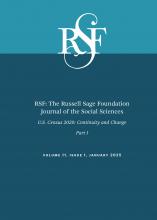Research Article
Open Access
How Ethnoracial Groups Spend Their Time
Sarah James, Elizabeth Wrigley-Field
RSF: The Russell Sage Foundation Journal of the Social Sciences January 2025, 11 (1) 178-200; DOI: https://doi.org/10.7758/RSF.2025.11.1.09
Sarah James
aSurvey statistician in the Demographic and Decennial Research Group of the Center for Economic Studies at the U.S. Census Bureau, United States
Elizabeth Wrigley-Field
bAssociate professor in the Department of Sociology and the Minnesota Population Center at the University of Minnesota, United States

REFERENCES
- ↵
- American Psychological Association
- ↵
- Bianchi, Suzanne M.,
- Melissa A. Milkie,
- Liana C. Sayer, and
- John P. Robinson
- ↵
- Bianchi, Suzanne M.,
- Liana C. Sayer,
- Melissa A. Milkie, and
- John P. Robinson
- ↵
- ↵
- Bloome, Deirdre, and
- Bruce Western
- ↵
- ↵
- Buchanan, Tom,
- Adian McFarlane, and
- Anupam Das
- ↵
- Colen, Cynthia G.,
- Kelsey J. Drotning,
- Liana C. Sayer, and
- Bruce Link
- ↵
- ↵
- Curtis, Chadwick,
- Julio Garín, and
- Robert Lester
- ↵
- Danvers, Alexander F.,
- Liliane D. Efinger,
- Matthias R. Mehl,
- Peter J. Helm,
- Charles L. Raison,
- Angelina J. Polsinelli,
- Suzanne A. Moseley, and
- David A. Sbarra
- ↵
- Derenoncourt, Ellora,
- Chi Hyun Kim,
- Moritz Kuhn, and
- Moritz Schularick
- ↵
- ↵
- Fisher, Kimberley,
- Jonathan Gershuny,
- Sarah M. Flood,
- Joan Garcia Roman, and
- Sandra L. Hofferth
- ↵
- Flood, Sarah M.,
- Liana C. Sayer,
- Daniel Backman, and
- Annie Chen
- ↵
- Ford, Tiffany N.,
- Jennifer M. Silva,
- Morgan Welch, and
- Isabel V. Sawhill
- ↵
- ↵
- ↵
- ↵
- Groshen, Erica L., and
- Harry J. Holzer
- ↵
- Herd, Pamela,
- Hilary Hoynes,
- Jamila Michener, and
- Donald Moynihan
- ↵
- Herd, Pamela, and
- Donald P. Moynihan
- ↵
- Hofferth, Sandra L.,
- Sarah M. Flood,
- Matthew Sobek, and
- Daniel Backman
- ↵
- ↵
- ↵
- Ice, Erin
- ↵
- ↵
- Jackson, Michelle
- ↵
- ↵
- Katz, Michael B.,
- Mark J. Stern, and
- Jamie J. Fader
- ↵
- Kephart, Lindsay
- ↵
- Krueger, Alan B
- ↵
- Krueger, Alan B.,
- Daniel Kahneman,
- David Schkade,
- Norbert Schwarz, and
- Arthur A. Stone
- ↵
- Kwate, Naa Oyo A
- ↵
- ↵
- ↵
- Logan, John R
- ↵
- Long, Christopher R., and
- James R. Averill
- ↵
- McCrate, Elaine
- ↵
- McLafferty, Sara, and
- Valerie Preston
- ↵
- ↵
- Park, Hyunjoon,
- Matthew Sheen, and
- Paula Clark
- ↵
- Permanyer, Iñaki,
- Isaac Sasson, and
- Francisco Villavicencio
- ↵
- ↵
- ↵
- ↵
- Robinson, John P
- ↵
- Salganik, Matthew J.,
- Ian Lundberg,
- Alexander T. Kindel,
- Caitlin E. Ahearn,
- Khaled Al-Ghoneim,
- Abdullah Almaatouq,
- Drew M. Altschul, et al
- ↵
- Sayer, Liana C
- ↵
- ↵
- ↵
- Sevilla, Almudena,
- Jose I. Gimenez-Nadal, and
- Jonathan Gershuny
- ↵
- Silverstein, Merril, and
- Linda J. Waite
- ↵
- ↵
- Thomas Tobin, Courtney S.,
- Christy L. Erving,
- Taylor W. Hargrove, and
- Lacee A. Satcher
- ↵
- Trieu, Monica M
- ↵
- U.S. Bureau of Labor Statistics
- ↵
- U.S. Bureau of Labor Statistics
- ↵
- Weeden, Kim A.,
- Youngjoo Cha, and
- Mauricio Bucca
- ↵
- Williams, David R
- ↵
- Wilson, George,
- Ian Sakura-Lemessy, and
- Jonathan P. West
- ↵
- Zenk, Shannon N.,
- Amy J. Schulz,
- Barbara A. Israel,
- Sherman A. James,
- Shuming Bao, and
- Mark L. Wilson
In this issue
How Ethnoracial Groups Spend Their Time
Sarah James, Elizabeth Wrigley-Field
RSF: The Russell Sage Foundation Journal of the Social Sciences Jan 2025, 11 (1) 178-200; DOI: 10.7758/RSF.2025.11.1.09





